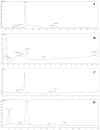Exploiting exopolysaccharides from microalgae to block the toxic in vitro effects of Bothrops sp. venom
- PMID: 40594944
- PMCID: PMC12219311
- DOI: 10.1038/s41598-025-08825-2
Exploiting exopolysaccharides from microalgae to block the toxic in vitro effects of Bothrops sp. venom
Abstract
Snakebite envenomation causes various toxic effects in humans, including death. Antivenoms are effectively prevent death but cannot completely block local muscle tissue damage, resulting in amputation and disability; thus, complementary therapies are needed. In this study, the ability of exopolysaccharides extracted from the microalgae Chlorella sorokiniana, Scenedesmus obliquus, Nannochloris sp. Naumann, and Scenedesmus acuminatus to inhibit the proteolytic, plasma coagulant, and phospholipase A2 (PLA2) activities of Bothrops jararaca, B. jararacussu, and B. neuwiedi venoms was assessed. Exopolysaccharides from C. sorokiniana, S. obliquus, Nannochloris sp. Naumann, and S. acuminatus inhibited the proteolytic activity of B. jararaca venom by 25%, 99%, 97%, and 13%, respectively; B. jararacussu venom by 14%, 50%, 46%, and 12%, respectively; and B. neuwiedi venom by 1%, 78%, 62%, and 1%, respectively. Exopolysaccharides from S. obliquus and Nannochloris sp. Naumann prevented the coagulation induced by snake venom and decreased the PLA2 activity by 15% and 30%, respectively. None of the four exopolysaccharides lysed red blood cells and, thus, can be considered as nonhemotoxic compounds. Therefore, microalgae exopolysaccharides may be a candidate as complementary therapies for envenomation by snakes in regions where such incidents are common.
Keywords: Antidote; Exopolysaccharides; Microalgae; Neutralization; Snake venoms; Toxic activities.
© 2025. The Author(s).
Conflict of interest statement
Declarations. Competing interests: The authors declare no competing interests.
Figures




Similar articles
-
Effect of Seaweed-Derived Fucoidans from Undaria pinnatifida and Fucus vesiculosus on Coagulant, Proteolytic, and Phospholipase A2 Activities of Snake Bothrops jararaca, B. jararacussu, and B. neuwiedi Venom.Toxins (Basel). 2024 Apr 12;16(4):188. doi: 10.3390/toxins16040188. Toxins (Basel). 2024. PMID: 38668613 Free PMC article.
-
Phenotypic dichotomy in Crotalus durissus ruruima venom and potential consequences for clinical management of snakebite envenomations.PLoS Negl Trop Dis. 2025 Aug 1;19(8):e0013296. doi: 10.1371/journal.pntd.0013296. eCollection 2025 Aug. PLoS Negl Trop Dis. 2025. PMID: 40749023 Free PMC article.
-
A murine experimental model of the pulmonary thrombotic effect induced by the venom of the snake Bothrops lanceolatus.PLoS Negl Trop Dis. 2024 Oct 2;18(10):e0012335. doi: 10.1371/journal.pntd.0012335. eCollection 2024 Oct. PLoS Negl Trop Dis. 2024. PMID: 39356725 Free PMC article.
-
Targets Involved in the Pharmacology of Bothrops Snakebite: Statu Quo and Future Perspectives.Curr Drug Targets. 2025;26(7):454-469. doi: 10.2174/0113894501352925250225045555. Curr Drug Targets. 2025. PMID: 40017248 Review.
-
Antivenom for European Vipera species envenoming.Clin Toxicol (Phila). 2017 Jul;55(6):557-568. doi: 10.1080/15563650.2017.1300261. Epub 2017 Mar 28. Clin Toxicol (Phila). 2017. PMID: 28349771
References
MeSH terms
Substances
Grants and funding
- 13.2251.21.0262/Ministry of Education and Science of the Russian Federation
- 13.2251.21.0262/Ministry of Education and Science of the Russian Federation
- 13.2251.21.0262/Ministry of Education and Science of the Russian Federation
- 304719/2012-9/Conselho Nacional de Desenvolvimento Científico e Tecnológico
- 309823/2021-8/Conselho Nacional de Desenvolvimento Científico e Tecnológico
LinkOut - more resources
Full Text Sources

